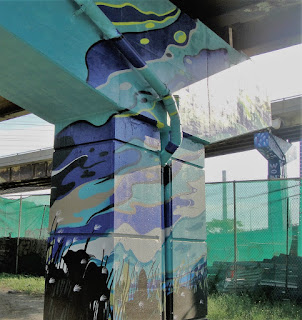
Well, actually, Toronto’s
Don River really doesn’t have a mouth. At its southern end the river makes a 90 degree turn and becomes the
Keating Channel, which then lets into the Inner Harbour 750 metres to the west. In the above image, the lower bridge carries
Lake Shore Boulevard East while the eastern end of the
Gardiner Expressway lies above. Keating Channel is just beyond.
This area just north of Keating Channel is a very busy place. Here, the Don is crossed by a footbridge (on which I stood to take the above photo), another bridge supporting both Lake Shore Boulevard and a railway track, and the ramps connecting the Gardiner Expressway to the
Don Valley Parkway and to Lake Shore Boulevard. This is truly an urban river scene.
The water of the Don is heavily polluted and looks it. But much effort has gone into restoring the river. In 1989, the
Task Force to Bring Back the Don was created; and since then, wetlands along the river have been restored and hundreds of thousands of plants and trees have been planted. Pollution levels in the river have been reduced and restorative work continues. However, the Don remains one of Canada’s dirtiest rivers.

↑ I felt sorry for these two ducks swimming in the river.
This area of the Don River can be reached in pleasant fashion by bicycle. The Lake Shore East Recreational Trail follows Lake Shore Boulevard from Coxwell Avenue to the Don River. The Lower Don Recreational Trail follows the Don River south from Overlea Boulevard to Lake Shore Boulevard, where it hooks briefly westward, ending at Parliament Street.

↑ This railway track crosses the river just to the north of Lake Shore Boulevard. The on-ramp to the Gardiner Expressway can be seen at the top right.

↑ Looking west from the east side of the river.

↑ Looking east from the west side of the river.

↑ Looking southwest from the footbridge.

↑ Looking northeast to the footbridge.

↑ Looking north from the footbridge. These are the ramps connecting the Don Valley Parkway to the Gardiner Expressway.

↑ The bike path west of the footbridge.

↑ Under the on-ramp to the Don Valley Parkway. This is just west of the river.

↑ On the right is the on-ramp to the Don Valley Parkway. This ramp, although it looks a bit like a long slide, is not nearly as fun as a slide...

↑ Looking to the footbridge from the west side of the river. You wouldn't want to swim, fish, or picnic here, but the area certainly has many impressive sights.
All photos by Rob Tilley.
Sources:
Ford, Ray –
“Death and Rebirth on the Don River”
Wikipedia –
“Don River (Ontario)”
City of Toronto –
“The Don River and Central Waterfront Project: Cleaning Up Our Waterways"















































